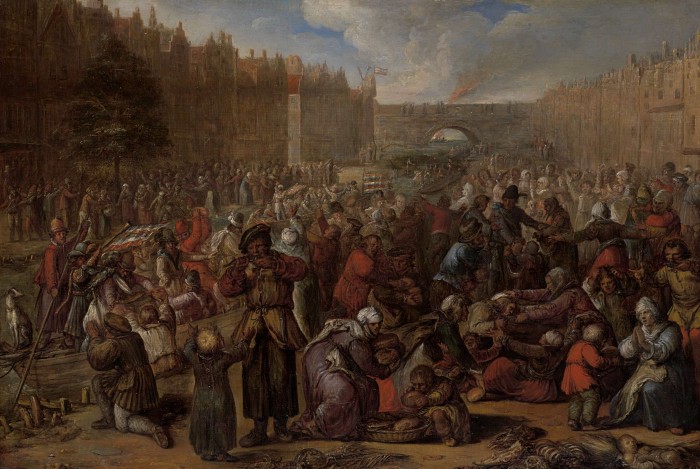Date of Conference: 11-13 April 2014
Deadline for CFP: 01.09.2013
Information from the organizers, 21 July 2013
The life and work world of early modern artists were characterised by profound crises and upheavals which have been treated only in an elementary fashion by social historians. The planned conference does not wish to pinpoint an individually experienced crisis (for example, death of the wife, artist’s illness) but extreme events leading to turning points in history with an effect on the artist as an individual. We have in mind especially the Reformation, the Thirty Years’ War, the division of the Netherlands, the French Revolution, persecution of the Huguenots, epidemics or famines.
The life and work world of early modern artists were characterised by profound crises and upheavals which have been treated only in an elementary fashion by social historians. The planned conference does not wish to pinpoint an individually experienced crisis (for example, death of the wife, artist’s illness) but extreme events leading to turning points in history with an effect on the artist as an individual. We have in mind especially the Reformation, the Thirty Years’ War, the division of the Netherlands, the French Revolution, persecution of the Huguenots, epidemics or famines.
Because of the proximity to the 2017 anniversary of the Reformation, the conference would like to focus on the era of the Reformation and Counter-Reformation, with the time frame being limited to around 1800 with the European revolutions. Sample questions which might be posed in the lectures: – How did the artist deal with times of crisis? – Which strategies did he use; how flexible was he in adapting to the new situation? – What role did the phenomenon of artist emigration play? – How did a change in religion or location come about, and what effect did such changes have on former and new patrons of the artist?
Of special interest here is the question of how the artist’s lament is articulated and formulated and in what framework it circulated. Along with written sources for the artist’s lament, for example, complaints to the town council, there are also numerous visualisations of the artist’s lament not yet examined by research such as broadsheets, invitation cards for auctions or caricatures appearing in widespread early modern newspapers. The Irsee Art History Forum plans a publication of the articles shortly afterwards and is interested exclusively in texts which have not yet been printed or are to be printed in this form. The organisers are endeavoured to provide full financing for travel and accommodations costs, including all meals. The participants are obligated to have their articles finished for printing in late summer 2014.
Time: 11-13 April 2014
Place: Irsee Schwaben Academy, Germany
Organisers: Irsee Schwaben Academy (Dr. Markwart Herzog, Director of the Irsee Schwaben Academy) and Dr. Sylvia Heudecker (Director of Studies at the Irsee Schwaben Academy) and artifex (Dr. Birgit Ulrike Münch, Senior Lecturer for the Chair for Art History at the University of Trier and Dr. Andreas Tacke, Professor, Chairman of Art History at the University of Trier).
Submission deadline for suggestions (keyword Künstlerklage/artist’s lament) with a one-page synopsis of the planned lecture as well as a one-page CV and a publication list: 01.09.2013
Contact:
Dr. Birgit Ulrike Münch M.A.
Akademische Rätin
Lehrstuhl für Kunstgeschichte
Universität Trier, FB III
D-54286 Trier
Tel. +49 / (0)651 / 201-4481
e-mail: muench@uni-trier.de
Irsee Art History Forum
The Irsee Art History Forum, founded in 2012, plans annual Spring Academies. In the following years, these conferences will be dedicated to the research area “the artist and society”. The questions of interest for the art history forum in this cycle are how the artist was situated in his society, under what conditions he marketed his art, conceived of his ideas, presented himself to the public, made use of an image and to what extent he was dependent on his patrons, art agents, art advisors and buyers.
The Irsee Art History Forum offers a framework for intra- as well as interdisciplinary research. Its goal is to combine genuine approaches into research of art history with all disciplines, methods and questions of (historical) cultural studies. In an annual call for papers we request suggestions for articles on a specific topic. It is intended that young academics, that is, researchers in the doctoral or post-doctoral phase, are to be included to a great degree. At the same time, the forum has as its goal developing topics academically which are currently of public interest to bring innovative academic approaches into the public eye.
Each Spring Academy will publish the conference results in the Michael Imhof Publishing Company (Petersberg), which will then be presented in the respective following Spring Academy. We expect commitment by the participants. We define Academy as a discussion forum and are therefore not interested in “conference hopping” where a participant’s own lecture is in the limelight and he/she participates otherwise only partially in the conference. In fact, the Spring Academies are to offer a forum for academic exchange and mutually developed innovative approaches.
The ideal conference conditions at the Irsee Schwaben Academy contribute to intensive use of the two-and-a-half days together.

